Journal Description
Challenges
Challenges
is an interdisciplinary, peer-reviewed, open access journal that welcomes contributions to any problem, or any aspect of the Grand Challenges facing our world and our societies today. It is published quarterly online by MDPI and addresses the pressing need to accelerate integrated cross-sectoral discourse and collaborative solutions to improve every aspect of life on our planet. Challenges is part of the growing planetary health movement. The Nova Network (formerly inVIVO Planetary Health) is affiliated with Challenges, and is a member of the Planetary Health Alliance.
- Open Access— free for readers, with article processing charges (APC) paid by authors or their institutions.
- High Visibility: indexed within RePEc, Gale, EBSCO, ProQuest, and other databases.
- Rapid Publication: manuscripts are peer-reviewed and a first decision is provided to authors approximately 27.4 days after submission; acceptance to publication is undertaken in 2.8 days (median values for papers published in this journal in the second half of 2023).
- Recognition of Reviewers: reviewers who provide timely, thorough peer-review reports receive vouchers entitling them to a discount on the APC of their next publication in any MDPI journal, in appreciation of the work done.
Latest Articles
The Folly of Food Waste amidst Food Insecurity in the United States: A Literature Review
Challenges 2024, 15(2), 21; https://doi.org/10.3390/challe15020021 - 18 Apr 2024
Abstract
Food insecurity is an economic and social condition that involves individuals having limited or uncertain access to healthy food. Despite the well-intentioned efforts of both governmental and not-for-profit organizations in addressing food insecurity, well over one-in-ten households in the U.S., the wealthiest nation
[...] Read more.
Food insecurity is an economic and social condition that involves individuals having limited or uncertain access to healthy food. Despite the well-intentioned efforts of both governmental and not-for-profit organizations in addressing food insecurity, well over one-in-ten households in the U.S., the wealthiest nation in the world, experience food insecurity every year. The objective of this literature review was to identify and explicate the methods and outcomes of food insecurity interventions that have been conducted among U.S. adults. This literature review identified 38 studies detailing several government programs and research interventions designed to address food insecurity. Results from the review highlight how the Supplemental Nutrition Assistance Program (SNAP), The Emergency Food Assistance Program (TEFAP), and not-for profit food banks have demonstrated success in improving food insecurity. However, the prevalence of food insecurity among U.S. households has fluctuated without any sustained decreases that achieve a food insecurity rate that remains below 10 percent of the population. Food waste, which refers to food that is edible yet discarded at the retail or consumption phases, is rampant in the U.S., as approximately 30 percent (66.5 million tons) of edible food is wasted after leaving the farm every year. Food waste prevention efforts that involve rescuing edible, nutritious food and redistributing it to individuals who are food insecure can promote both environmental- and public health through simultaneous reductions in food waste and food insecurity.
Full article
Open AccessArticle
The Socio-Spatial Distribution and Equity of Access to Urban Parks: A Case Study of Bengaluru, India
by
Nilanjan Bhor and Dhananjayan Mayavel
Challenges 2024, 15(2), 20; https://doi.org/10.3390/challe15020020 - 16 Apr 2024
Abstract
Given the effect of urbanization on land use and the allocation and implementation of urban green spaces, this paper attempts to analyze the distribution and accessibility of public parks in India’s Bengaluru city (previously known as Bangalore). Availability, accessibility, and utilization—the key measures
[...] Read more.
Given the effect of urbanization on land use and the allocation and implementation of urban green spaces, this paper attempts to analyze the distribution and accessibility of public parks in India’s Bengaluru city (previously known as Bangalore). Availability, accessibility, and utilization—the key measures of Urban Green Spaces (UGS)—are mostly used in health research and policy and are important components of Planetary Health Equity in the context of studying UGSs and health. A geo-spatial method was used for mapping the park’s distribution and measuring its accessibility, using road network data. To understand equitable access to the parks, four socio-economic parameters—population density, the percentage of the population below 6 years of age, the proxy wealth index, and scheduled caste population—were correlated with the parks’ accessibility. This spatial distribution revealed that 19 of 198 wards did not have a single park and that 36 wards only had one park. About 25–29% of wards did not have accessibility to neighborhood-level and community-level parks within a 400–800 m distance. These parks must be accessible within a walking distance of 400–800 m but were found to most likely be inaccessible on the periphery of the city where the population density is low and the children population is high, in comparison to the central part of the city. Similarly, parks were found to be inaccessible in the eastern part of the city where the scheduled caste population is high and also found to be inaccessible for the low-income neighborhoods residing in the western part and southern periphery of the city, indicating the uneven distribution of and inequitable access to public parks. Our study proposes a reshaping of both neighborhood parks and community parks in an attempt to look beyond biodiversity, through the planetary health equity approach, by noting that, while biodiversity indirectly has a positive effect on health, public parks should not only be considered as advancing environmental sustainability and climate resilience, but also as improving the health and wellbeing of the population. Affirmative action in terms of the availability of public parks with adequate area requirements and essential services at a neighborhood scale is required to redress the inequity of access; in addition, the accessibility of parks must be considered important during urban planning.
Full article
(This article belongs to the Special Issue Planetary Health: From Evidence to Action–Confronting Reality (Including Submissions Associated with the 2024 Planetary Health Summit (PHAM2024))
►▼
Show Figures
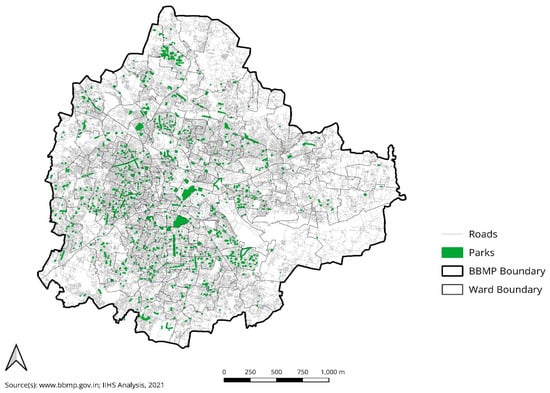
Figure 1
Open AccessArticle
How Constructionist Perspectives on Learning Can Improve Learning and Prevent Accidents in High-Risk Industries
by
Thomas Wold
Challenges 2024, 15(2), 19; https://doi.org/10.3390/challe15020019 - 05 Apr 2024
Abstract
Management systems containing procedures, checklists, and descriptions for how various tasks should be conducted are often used in high-risk industries. Much has been written about the judicial and technological concerns of management systems, but less has been written on how to train staff
[...] Read more.
Management systems containing procedures, checklists, and descriptions for how various tasks should be conducted are often used in high-risk industries. Much has been written about the judicial and technological concerns of management systems, but less has been written on how to train staff in the use of them. Through a cognitive-constructionist perspective combined with social constructivism, this paper discusses how staff training can be designed to fit the characteristics of the workers. This paper focuses on how people learn in different ways, and how this is related to perspectives on knowledge. The method used is semi-structured interviews with twenty-seven workers in two different companies operating in the oil and gas-producing industry. The workers got only a short web-based theory course on the management system, with no practical exercises, repetitions, or other types of follow-ups. This is a signal that the management system is of less importance, and many of the workers thought they did not need it. Training must be designed to fit the workers, with practical exercises, repetition, and possibilities for on-the-job training. Accidents in this sector can cause human losses and great environmental harm, and this paper argues that better training of staff can prevent such accidents and reduce harm to the environment.
Full article
(This article belongs to the Section Planetary Health)
Open AccessViewpoint
Prevention Science Can’t Wait: An Interview with Dr. Diana H. Fishbein
by
Alan C. Logan and Diana H. Fishbein
Challenges 2024, 15(2), 18; https://doi.org/10.3390/challe15020018 - 26 Mar 2024
Abstract
►▼
Show Figures
In an ongoing series of interviews, Challenges Advisory Board member and Nova Institute for Health Fellow Alan C. Logan meets with thought leaders, scientists, scholars, healthcare professionals, artisans, and visionaries concerned about health at the scale of persons, places, and the planet. Here,
[...] Read more.
In an ongoing series of interviews, Challenges Advisory Board member and Nova Institute for Health Fellow Alan C. Logan meets with thought leaders, scientists, scholars, healthcare professionals, artisans, and visionaries concerned about health at the scale of persons, places, and the planet. Here, Dr. Diana H. Fishbein responds to a set of questions posed by Challenges. For over forty years, Dr. Fishbein, a neuroscientist and criminologist by training, has been at the forefront of research examining the intersections of biological, environmental, social, and physical factors as they relate to brain development, functioning, risky behavior, and life outcomes. Within this broad-ranging career, Dr. Fishbein was among the very first to conduct a dietary intervention study (eliminating refined carbohydrate foods) examining behavioral outcomes (i.e., nutritional psychiatry). This, combined with related research endeavors and experiences, led to a wider-lens view of prevention research, a desire to understand the physiological mechanisms that explain heterogeneity in positive and/or unfavorable outcomes in prevention programs, and a dynamic career devoted to the science of prevention. Here, Dr. Fishbein reflects on her career and its many twists and turns through a range of interdisciplinary work. Shediscusses prevention science through the lens of future possibilities and the need for scientists to lean toward advocacy and supporting evidence-based policy changes. Prevention science, as Dr. Fishbein explains, is at the heart of the many interconnected challenges of our time.
Full article

Figure 1
Open AccessViewpoint
The Natural World in Western Thought
by
Mazhar Ali Jarwar, Stefano Dumontet and Vincenzo Pasquale
Challenges 2024, 15(1), 17; https://doi.org/10.3390/challe15010017 - 20 Mar 2024
Abstract
The Western approach to the natural world, considering “nature” as an object of scientific scrutiny and of exploitation for economic purposes, results in a separateness and subsequent alienation from nature. The overarching aim of this paper is to emphasize the limitations and consequences
[...] Read more.
The Western approach to the natural world, considering “nature” as an object of scientific scrutiny and of exploitation for economic purposes, results in a separateness and subsequent alienation from nature. The overarching aim of this paper is to emphasize the limitations and consequences of this approach, including how nature is perceived, the value attributed to nature, and the substantial denial of cultural contributions from non-Western philosophical and scientific backgrounds. We also consider the Western attempt at balancing industrial and technological endeavors, aimed at preserving ecological equilibria. In this framework, we argue that the current ever-increasing concern about sustainability cannot be decoupled from the perception of nature and natural values, whether material, aesthetic, or spiritual. Therefore, modern sustainability challenges, mainly attributable to Western overexploitation of nature and natural resources, need to be considered in the context of the limited Western paradigms, which often leave the very definition of nature unanswered. We argue that efforts to ease the anthropogenic pressure on natural ecosystems, leading to their degradation, cannot be uniquely bounded by Western science and its technological appendices.
Full article
Open AccessArticle
Low-Cost Non-Contact Forest Inventory: A Case Study of Kieni Forest in Kenya
by
Cedric Kiplimo, Ciira wa Maina and Billy Okal
Challenges 2024, 15(1), 16; https://doi.org/10.3390/challe15010016 - 18 Mar 2024
Abstract
►▼
Show Figures
Forests are a vital source of food, fuel, and medicine and play a crucial role in climate change mitigation. Strategic and policy decisions on forest management and conservation require accurate and up-to-date information on available forest resources. Forest inventory data such as tree
[...] Read more.
Forests are a vital source of food, fuel, and medicine and play a crucial role in climate change mitigation. Strategic and policy decisions on forest management and conservation require accurate and up-to-date information on available forest resources. Forest inventory data such as tree parameters, heights, and crown diameters must be collected and analysed to monitor forests effectively. Traditional manual techniques are slow and labour-intensive, requiring additional personnel, while existing non-contact methods are costly, computationally intensive, or less accurate. Kenya plans to increase its forest cover to 30% by 2032 and establish a national forest monitoring system. Building capacity in forest monitoring through innovative field data collection technologies is encouraged to match the pace of increase in forest cover. This study explored the applicability of low-cost, non-contact tree inventory based on stereoscopic photogrammetry in a recently reforested stand in Kieni Forest, Kenya. A custom-built stereo camera was used to capture images of 251 trees in the study area from which the tree heights and crown diameters were successfully extracted quickly and with high accuracy. The results imply that stereoscopic photogrammetry is an accurate and reliable method that can support the national forest monitoring system and REDD+ implementation.
Full article
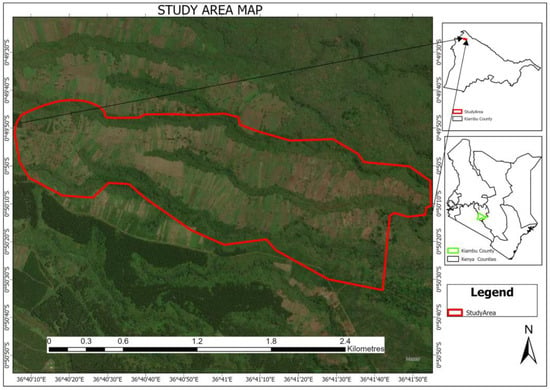
Figure 1
Open AccessReview
Bitcoin Use Cases: A Scoping Review
by
Emma Apatu and Poornima Goudar
Challenges 2024, 15(1), 15; https://doi.org/10.3390/challe15010015 - 14 Mar 2024
Abstract
This scoping review examines individual and societal use cases of Bitcoin in the peer-reviewed literature. Arksey and O’Malley’s scoping review methodology was used, and a comprehensive search strategy was employed using Web of Science and Engineering village databases. Articles were screened at the
[...] Read more.
This scoping review examines individual and societal use cases of Bitcoin in the peer-reviewed literature. Arksey and O’Malley’s scoping review methodology was used, and a comprehensive search strategy was employed using Web of Science and Engineering village databases. Articles were screened at the title and abstract and full-text levels by the authors. One author conducted data extraction to summarize the data. In total, 17 relevant articles were included in this review. Investment and savings were the most widely reported use cases at an individual level, with payments and international transfers less frequently reported in the studies. Only two studies reported on societal use cases of legal tender; however, only one country, El Salvador, executed its intention. Our study suggests that Bitcoin is being used by individuals around the world with little report of societal (e.g., country adoption) uses cases. For example, there is evidence on the internet and on a grass-roots level that Bitcoin is being used in circular economies; however, the peer-reviewed literature may not yet capture the extent and full benefits and challenges. As such, we provide ideas for future research to more comprehensively explore Bitcoin uses and its impacts on individuals and society.
Full article
(This article belongs to the Special Issue The Bitcoin Challenge: Building the Evidence Base to Support Credible Environmental, Economic and Social Decision Making)
►▼
Show Figures
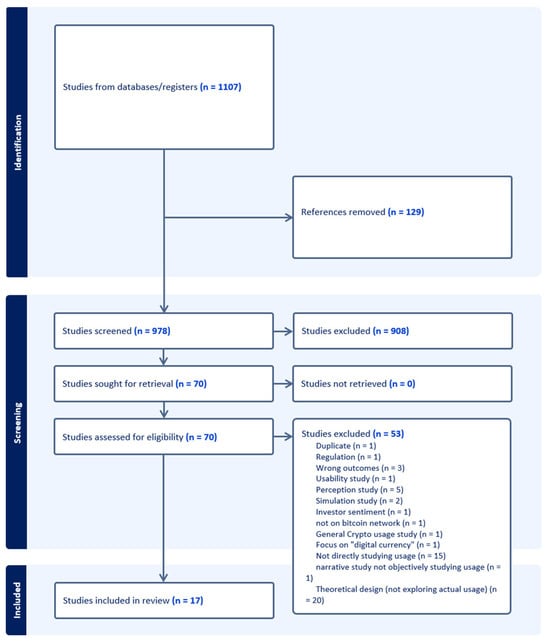
Figure 1
Open AccessReview
Beneficial Properties and Sustainable Use of a Traditional Medicinal Plant: Griffonia simplicifolia
by
Amirhossein Nazhand, Alessandra Durazzo, Massimo Lucarini, Fabrizia Guerra, Angélica Gomes Coêlho, Eliana B. Souto, Daniel Dias Rufino Arcanjo and Antonello Santini
Challenges 2024, 15(1), 14; https://doi.org/10.3390/challe15010014 - 12 Mar 2024
Abstract
►▼
Show Figures
Since ancient times, medicinal plants have been a universal source of biologically active substances with high potential for the treatment of various diseases and disorders. For centuries, traditional communities have often relied on medicinal plants to treat health problems. Therefore, accurate information is
[...] Read more.
Since ancient times, medicinal plants have been a universal source of biologically active substances with high potential for the treatment of various diseases and disorders. For centuries, traditional communities have often relied on medicinal plants to treat health problems. Therefore, accurate information is required and knowledge about traditional medicinal plants requires evaluation, and great attention should be given to the possible integration of these plants as therapeutic agents or as complements to conventional pharmacological therapies in the healthcare system. Recently, Griffonia simplicifolia (DC.) Baill., initially used as a holistic remedy, has attracted attention from many researchers and consumers because of its multiple health-promoting effects. This growing interest prompted us to give an updated review of the botanical, geographical, historical, and therapeutic potentials of Griffonia simplicifolia (DC.) Baill. in terms of its in vitro and in vivo health effects, nutritional uses, and possible applications in line with biodiversity and sustainability concepts. This paper also presents a quantitative research analysis of the published studies related to this plant that are available in the literature. To retrieve the publications related to this plant, a bibliographic search was carried out using the Scopus database. The bibliometric data were extracted and processed using VOSviewer software (v.1.6.16, 2020). Technological possible applications in terms of patents request presented was also performed. A total of 1386 publications, from the year 1970 to the year 2021, were obtained by the literature search, and these had been collectively cited 38,805 times. The large amount of literature data available documents the interest in this plant’s use as a tool for integrating traditional holistic healing approach, e.g., using plants, herbs, and holistic remedies, into the healthcare system as supporting tools and/or therapeutic agents, which is a current worldwide challenge.
Full article
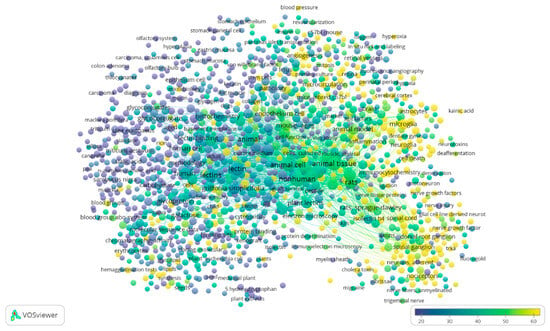
Figure 1
Open AccessViewpoint
A Framework for Effective Collaboration with Crisis-Affected Communities
by
Jo Rose and Claudia Milena Adler
Challenges 2024, 15(1), 13; https://doi.org/10.3390/challe15010013 - 09 Mar 2024
Abstract
In 2016, a localisation agenda was set across the international aid industry with the understanding that humanitarian interventions need to be led by local actors and local communities. Despite international agreements, the localisation efforts are largely failing. This paper demonstrates the challenges that
[...] Read more.
In 2016, a localisation agenda was set across the international aid industry with the understanding that humanitarian interventions need to be led by local actors and local communities. Despite international agreements, the localisation efforts are largely failing. This paper demonstrates the challenges that prevent effective collaboration between international humanitarian agencies and crisis-affected communities. It draws on evaluation reports to highlight an inability to learn lessons or follow recommendations from previous crises. Based on the authors’ experiences, we present a novel framework for effectively collaborating with crisis-affected communities. The Communities Framework provides a pathway to establishing effective community collaboration and locally owned and led humanitarian interventions. The importance of local leadership, trust building, and local context are at the heart of the framework. In light of the need for a more localised and decolonial humanitarian response, this framework supports humanitarian actors and the affected communities in moving from a charity-led approach to one of mutual aid. The paper draws on alternative notions of compassion from the Global South of contemporary humanitarian interventions as a philosophical foundation for the framework. Caring for others and the world is central to implementing an appropriate and effective humanitarian response. There remains a largely unexplored scope regarding the outcome of resolving crises when both humanitarian actors and affected communities work as equal partners and how that will shape modern humanitarianism as we understand it today.
Full article
(This article belongs to the Special Issue The Relationship between Sustainability and Inner Development: Towards More Integrative Worldviews, Paradigms, and Actions)
►▼
Show Figures
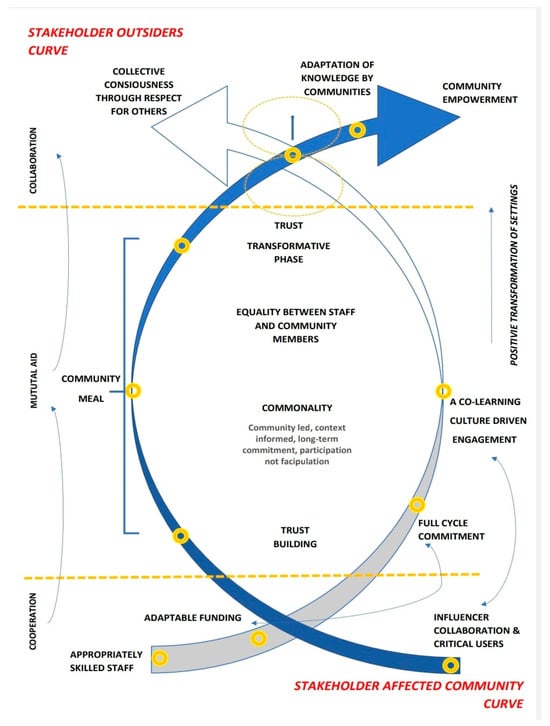
Figure 1
Open AccessReview
Access to Human Health Benefits of Forests in Rural Low and Middle-Income Countries: A Literature Review and Conceptual Framework
by
Ranaivo A. Rasolofoson
Challenges 2024, 15(1), 12; https://doi.org/10.3390/challe15010012 - 29 Feb 2024
Abstract
Forests are increasingly recognized for their beneficial roles in human health. However, there is a debate on how forest health benefits can be accessed equitably, particularly by vulnerable forest-dependent rural communities in low- and middle-income countries (LMICs). Access to forest health benefits is
[...] Read more.
Forests are increasingly recognized for their beneficial roles in human health. However, there is a debate on how forest health benefits can be accessed equitably, particularly by vulnerable forest-dependent rural communities in low- and middle-income countries (LMICs). Access to forest health benefits is determined by a range of interconnected means, including property rights, as well as natural, physical, human, social, and financial capital. This paper presents a literature review of the roles of means of access in shaping human health effects of forests. Evidence suggests that variations in these means of access are associated with varying ability to access forest health benefits. However, existing evidence is thin, mixed, and weak. A conceptual model is then developed to provide a framework for understanding how means of access moderate the effects of forests on health in rural LMICs to guide the generation of strong evidence. The multiple interconnected factors moderating the health effects of forests at the core of the conceptual framework promote the multisectoral and transdisciplinary approaches needed to enhance equitable access to forest health benefits.
Full article
(This article belongs to the Section Planetary Health)
►▼
Show Figures
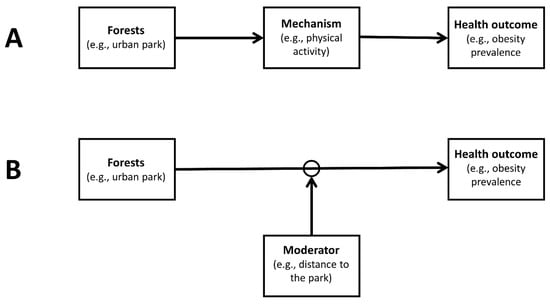
Figure 1
Open AccessViewpoint
Cultivating Resilience in Chaos: Localisation as a Mechanism for Sustainability and Inner Development in Syria’s Humanitarian Crisis
by
Jo Rose and Eslam Elbaaly
Challenges 2024, 15(1), 11; https://doi.org/10.3390/challe15010011 - 23 Feb 2024
Abstract
This article explores localisation in humanitarian settings as an example of sustainability and inner development. Through a case study from Syria, we discuss how localisation and remote management can lead to the mutual flourishing of individuals, communities and planetary health in the most
[...] Read more.
This article explores localisation in humanitarian settings as an example of sustainability and inner development. Through a case study from Syria, we discuss how localisation and remote management can lead to the mutual flourishing of individuals, communities and planetary health in the most challenging settings. Through localisation, we can rethink and reframe humanitarianism and integrate sustainability and personal development. Learning from these collaborations that highlight the importance of trust and interpersonal relations, the humanitarian and global health communities can reflect on how local individuals and communities can be further supported in their personal development and the sustainability of interventions that promote planetary health.
Full article
(This article belongs to the Special Issue The Relationship between Sustainability and Inner Development: Towards More Integrative Worldviews, Paradigms, and Actions)
Open AccessPerspective
Cultivating Pearls of Wisdom: Creating Protected Niche Spaces for Inner Transformations amidst the Metacrisis
by
Kira Jade Cooper, Don G. McIntyre and Dan McCarthy
Challenges 2024, 15(1), 10; https://doi.org/10.3390/challe15010010 - 22 Feb 2024
Abstract
The impetus for this paper emerges from the growing interest in leveraging inner transformations to support a global shift in ways of seeing and being. We caution that without sufficient individual and systemic maturity, inner transformations will be unable to hold the whole
[...] Read more.
The impetus for this paper emerges from the growing interest in leveraging inner transformations to support a global shift in ways of seeing and being. We caution that without sufficient individual and systemic maturity, inner transformations will be unable to hold the whole story and that attempts to drive paradigmatic shifts in ill-prepared systems will lead to insidious harms. As such, interventions for inner change will not have sufficient protected niche space to move beyond the boundaries of best practices towards wise practices. Drawing on Indigenous trans-systemics, we offer the metaphor of pearls as an invitation to recontextualize how inner transformations are conceived and approached in the metacrisis. To further develop this notion, we share a story of Wendigo and Moloch as a precautionary tale for the blind pursuit of inner and outer development. Weaving together metaphor, story, and scientific inquiry, we bring together Anishinaabe and Western knowledge systems for the purposes of healing and transformation. We hope that this paper will create space for wise practices—gifts from Creator to help sustain both Self and the World—to emerge, establish, and flourish. We invite readers on an exploration into the whole system of systems that are endemic to Anishinaabe cosmology, and a journey of reimagining new stories for collective flourishing amidst the metacrisis.
Full article
(This article belongs to the Special Issue Nurturing Connected Consciousness in the Anthropocene: Addressing Calls for Cultural and Spiritual Transformation as a Path to Personal, Collective, and Planetary Health)
►▼
Show Figures
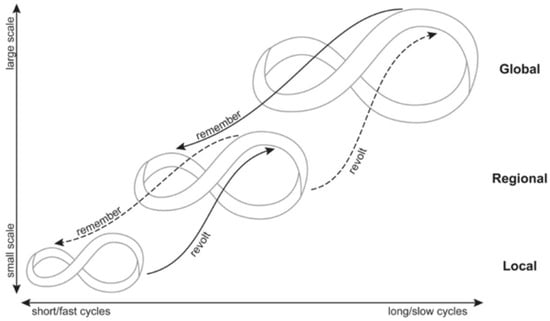
Figure 1
Open AccessArticle
Untangling the Processes of Bitcoin: An Organizational Learning Perspective
by
Rupert L. Matthews
Challenges 2024, 15(1), 9; https://doi.org/10.3390/challe15010009 - 21 Feb 2024
Abstract
Bitcoin is a complex phenomenon, whether in terms of the macro factors affecting its price or its role in the global energy infrastructure. However, extant literature pays too little attention to exploring the internal mechanisms of the protocol to be able to link
[...] Read more.
Bitcoin is a complex phenomenon, whether in terms of the macro factors affecting its price or its role in the global energy infrastructure. However, extant literature pays too little attention to exploring the internal mechanisms of the protocol to be able to link them to how they affect the visible characteristics of Bitcoin. This paper uses secondary data from highly reputable Bitcoin-focused sources to systematically map the processes that enable Bitcoin to function as a peer-to-peer cash system. Novelty is achieved by applying the established and versatile “4I” organisational learning framework to provide a new lens through which to understand how the processes within Bitcoin enable and facilitate different types of changes to the protocol. Further insights are provided to organisational learning from Bitcoin, in relation to managing mission-critical changes to organisational systems. In addition, it presents an option for dealing with irreconcilable internal differences to “hard-fork” part of the organisation. While the scope of this paper is limited to secondary data, opportunities for further research, including primary data collection, are outlined to explore how Bitcoin knowledge disseminates within communities or companies.
Full article
(This article belongs to the Special Issue The Bitcoin Challenge: Building the Evidence Base to Support Credible Environmental, Economic and Social Decision Making)
►▼
Show Figures

Figure 1
Open AccessFeature PaperArticle
Re-Imagining Alternative Futures through Empowerment
by
Claudia Milena Adler
Challenges 2024, 15(1), 8; https://doi.org/10.3390/challe15010008 - 20 Feb 2024
Abstract
The physical conquest of European powers on the rest of the world for the imposition of an accumulation of wealth monopoly and the destruction of native societies remains the foundation of the current global economy. Despite concepts of human flourishing, a term connected
[...] Read more.
The physical conquest of European powers on the rest of the world for the imposition of an accumulation of wealth monopoly and the destruction of native societies remains the foundation of the current global economy. Despite concepts of human flourishing, a term connected to empowerment that acts as an architectural structure within the development and sustainability discourse, the destruction of our planet and collective human wellbeing is not at the forefront of international political agendas. Scholars argue that the development agenda is maldevelopment due to the unrequested interventions delivered to communities, mainly in the Global South. Thus, despite the Sustainable Development Goals (SDGs), the implementation of inner dimensions that facilitate empowerment and are an integral part of development is missing from these sophisticated global frameworks. This research article repositions empowerment and compassion at the centre of the sustainable development discourse by drawing on the Inner Development Framework, particularly goal one—Being—‘Relationship to Self’ and goal three—Relating—‘Caring for others and the World’ and the Capabilities Theory as a guiding theoretical underpinning. On this basis, this article presents a qualitative interpretative study that examines the lived experience of women and their journeys to empowerment. The key findings indicate an intricate relationship between wellbeing and empowerment and the realisation of inner development as a tool to re-imagine alternative futures. In addition, industries are profiteering from a sustainability and development agenda that is failing to address the disablement of communities by a paternalistic approach to empowerment.
Full article
(This article belongs to the Special Issue The Relationship between Sustainability and Inner Development: Towards More Integrative Worldviews, Paradigms, and Actions)
►▼
Show Figures
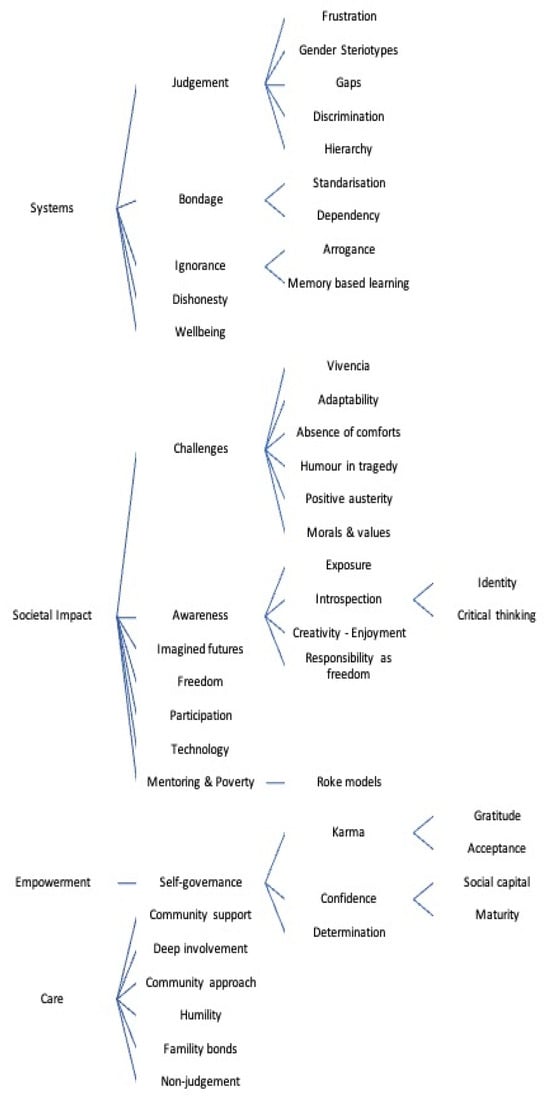
Figure 1
Open AccessOpinion
Theory of Constraints and Bitcoin: Introducing a New Fulcrum
by
Rupert L. Matthews
Challenges 2024, 15(1), 7; https://doi.org/10.3390/challe15010007 - 30 Jan 2024
Cited by 2
Abstract
Much of the attention on bitcoin relates to its ability to store value over time or whether you will one day by able to buy a cup of coffee with it. Much less attention is given to bitcoin’s potential role as a unit
[...] Read more.
Much of the attention on bitcoin relates to its ability to store value over time or whether you will one day by able to buy a cup of coffee with it. Much less attention is given to bitcoin’s potential role as a unit of account. This opinion piece proposes that bitcoin has potential to provide a consistent unit of account for organisations to adopt, but also to assist them in making and measuring meaningful business developments. The paper draws from the business improvement philosophy of Theory of Constraints to propose that unit of account, particularly within high inflation environments, is critical to consider. An illustrative case of a well-known publicly traded company, Microstrategy, provides an example and logic for a company choosing to integrate bitcoin into a business. The paper also gives attention to how the adoption of bitcoin can promote the development of renewable energy infrastructure and provide staff with opportunities for personal development to support their well-being. Opportunities for further research are identified to explore the integration of bitcoin within a business as well as with Theory of Constraints.
Full article
(This article belongs to the Special Issue The Bitcoin Challenge: Building the Evidence Base to Support Credible Environmental, Economic and Social Decision Making)
Open AccessProject Report
Food Systems and Planetary Health Nexus Elective: A Novel Approach to A Medical Education Imperative for the 21st Century
by
Modan Goldman, Aditya Vaidyam, Sindhu Parupalli, Holly Rosencranz, Davendra Ramkumar and Japhia Ramkumar
Challenges 2024, 15(1), 6; https://doi.org/10.3390/challe15010006 - 18 Jan 2024
Abstract
This is a report on an inaugural medical student elective, Microbiomes Matter: The Path to Regenerative Systems of Farm, Food, and Health, from the perspective of the student participants. Recognizing food as medicine is gaining support across many settings. However, little is
[...] Read more.
This is a report on an inaugural medical student elective, Microbiomes Matter: The Path to Regenerative Systems of Farm, Food, and Health, from the perspective of the student participants. Recognizing food as medicine is gaining support across many settings. However, little is known about how medical schools engage in this holistic approach. Integrating food systems and the connections to soil and human health through microbiomes into medical education represents a transformative shift towards more holistic healthcare practices. We describe the course content and impact of a medical school elective in food systems. This elective employed a systems lens and planetary health perspective to explore the impact of climatic factors and environmental degradation on farms, nutrition, and non-communicable lifestyle diseases. Through the two-week course, medical students gained insights into sustainable food systems, supply chains, and the importance of regenerative agriculture. The course also provided a comprehensive overview of the gut microbiome, nutrition, technologies, and the economics of food systems, including their impact on lifestyle diseases. By fostering a systems-oriented mindset, this elective better equips medical students to address the complex challenges of human and planetary health and promote regenerative, sustainable, culturally sensitive, and robust systems of farm, food, and health.
Full article
(This article belongs to the Special Issue Planetary Health: From Evidence to Action–Confronting Reality (Including Submissions Associated with the 2024 Planetary Health Summit (PHAM2024))
►▼
Show Figures
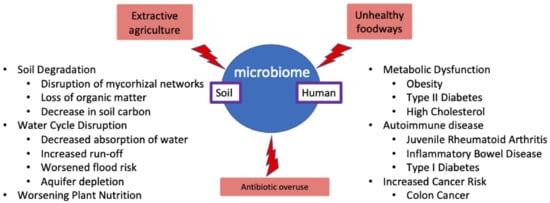
Figure 1
Open AccessReview
A Review of Environmental Challenges Facing Martian Colonisation and the Potential for Terrestrial Microbes to Transform a Toxic Extraterrestrial Environment
by
Daniel Keaney, Brigid Lucey and Karen Finn
Challenges 2024, 15(1), 5; https://doi.org/10.3390/challe15010005 - 12 Jan 2024
Abstract
►▼
Show Figures
Mars is a focus of New Space Age exploration and colonisation, but there are significant challenges to successful colonisation by humankind. Environmental microbes play a key role in supporting the ecosystems of Earth, especially within the biodegradation and bioremediation sectors. However, the repurposed
[...] Read more.
Mars is a focus of New Space Age exploration and colonisation, but there are significant challenges to successful colonisation by humankind. Environmental microbes play a key role in supporting the ecosystems of Earth, especially within the biodegradation and bioremediation sectors. However, the repurposed roles of microbes on Mars and their associated uses to colonists remain incompletely defined. The aim of this review was to examine the key roles of microbes on Earth and how they have been employed by humans to tackle four pivotal environmental challenges associated with the colonisation of Mars, namely the physical environment, the creation of a hospitable environment via terraforming, environmental sustainability and life support, and finally, renewable processing technologies. Some species of microbes were found to be tolerant of the ever-changing physical environment on Mars (freeze–thaw and UVC exposure) making them useful for bioremediation applications. Employing perchlorate-remediating microbes for their ability to bioremediate the soils of sodium perchlorate, which is present in Martian soils, in addition to their innate ability to cycle nutrients through the biosphere showed promise in establishing sustained crops to support colonists. The employment of terrestrial environmental microbes is a necessary part of overcoming key environmental challenges to successfully colonise Mars. Without this, future New Space exploration is unlikely to be successful.
Full article
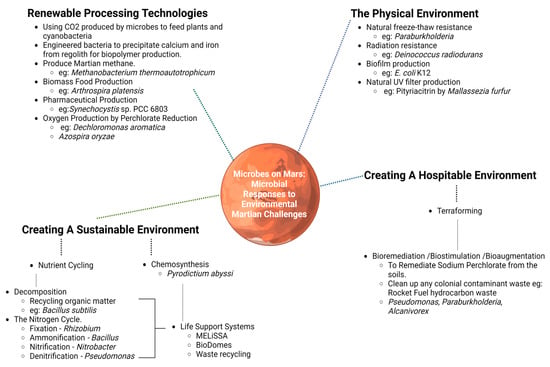
Figure 1
Open AccessArticle
Investigating Terrestrial and Extraterrestrial Bioremediation through Microbial Action Using Raman Spectroscopy
by
Daniel Keaney, Venkata V. B. Yallapragada, Liam O’Faolain, Ganga Chinna Rao Devarapu, Karen Finn and Brigid Lucey
Challenges 2024, 15(1), 4; https://doi.org/10.3390/challe15010004 - 11 Jan 2024
Abstract
►▼
Show Figures
Sodium perchlorate is a toxic salt-based compound found both terrestrially, (due to pollution) and extraterrestrially on the surface of Mars. Perchlorate pollution poses a risk to agricultural-based activities as once it enters soils/waterways it can be passed through the food chain via bioaccumulation.
[...] Read more.
Sodium perchlorate is a toxic salt-based compound found both terrestrially, (due to pollution) and extraterrestrially on the surface of Mars. Perchlorate pollution poses a risk to agricultural-based activities as once it enters soils/waterways it can be passed through the food chain via bioaccumulation. The purpose of the current study was to observe the perchlorate reduction potential of putative candidate bioremediation strains; Escherichia coli 25922 and E. coli 9079, Paraburkholderia fungorum, Deinococcus radiodurans and Dechloromonas aromatica both independently and in co-cultures, when exposed to 3000 mg/L (0.3%) sodium perchlorate. This was carried out in both a minimal medium environment and within an environment void of nutrients, using Raman spectroscopy to assess their potential for the bioremediation of Martian soils. The perchlorate reducing potential of all strains was 16% higher in reverse osmosis deionised water than in minimal medium, the former having a total absence of Nitrate. It was found that E. coli 25922 is a perchlorate reducer, which has not been previously described. Additionally, co-culturing of bacterial strains was found to have a higher bioremediation potential than individual strains. These findings suggest that not only could perchlorate pollution be remediated, but that the perchlorate composition of the Martian surface may support bioremediation microbial life, aiding in future colonisation.
Full article
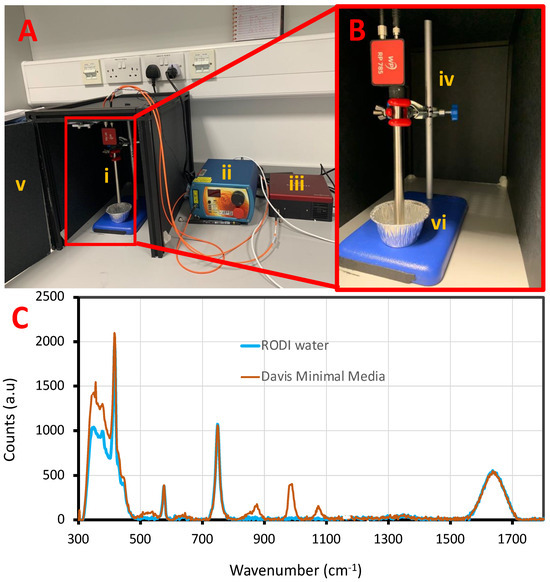
Figure 1
Open AccessReview
Addressing Planetary Health through the Blockchain—Hype or Hope? A Scoping Review
by
Rita Issa, Chloe Wood, Srivatsan Rajagopalan, Roman Chestnov, Heather Chesters and Geordan Shannon
Challenges 2024, 15(1), 3; https://doi.org/10.3390/challe15010003 - 31 Dec 2023
Abstract
Planetary health is an emergent transdisciplinary field, focused on understanding and addressing the interactions of climate change and human health, which offers interventional challenges given its complexity. While various articles have assessed the use of blockchain (web3) technologies in health, little consideration has
[...] Read more.
Planetary health is an emergent transdisciplinary field, focused on understanding and addressing the interactions of climate change and human health, which offers interventional challenges given its complexity. While various articles have assessed the use of blockchain (web3) technologies in health, little consideration has been given to the potential use of web3 for addressing planetary health. A scoping review to explore the intersection of web3 and planetary health was conducted. Seven databases (Ovid Medline, Global Health, Web of Science, Scopus, Geobase, ACM Digital Library, and IEEE Xplore) were searched for peer-reviewed literature using key terms relating to planetary health and blockchain. Findings were reported narratively. A total of 3245 articles were identified and screened, with 23 articles included in the final review. The health focus of the articles included pandemics and disease outbreaks, the health of vulnerable groups, population health, health financing, research and medicines use, environmental health, and the negative impacts of blockchain mining on human health. All articles included the use of blockchain technology, with others additionally incorporating smart contracts, the Internet of Things, artificial intelligence and machine learning. The application of web3 to planetary health can be broadly categorised across data, financing, identity, medicines and devices, and research. Shared values that emerged include equity, decentralisation, transparency and trust, and managing complexity. Web3 has the potential to facilitate approaches towards planetary health, with the use of tools and applications that are underpinned by shared values. Further research, particularly primary research into blockchain for public goods and planetary health, will allow this hypothesis to be better tested.
Full article
(This article belongs to the Special Issue Planetary Health: Building the Field and Growing the Movement (Including Manuscripts 2022 Planetary Health Annual Meeting and Festival))
►▼
Show Figures
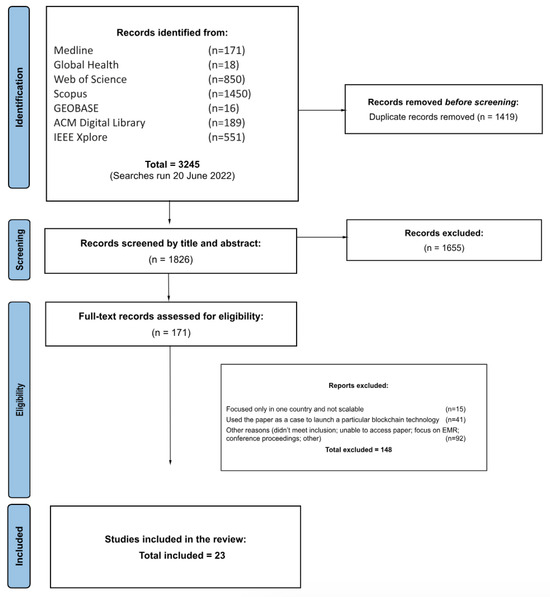
Figure 1
Open AccessArticle
Shifting Behaviors and Attitudes of Socially Stigmatizing Illnesses to Improve Wellbeing: A Conceptual Framework for Epilepsy
by
Ofhani Prudance Musekwa and Lufuno Makhado
Challenges 2024, 15(1), 2; https://doi.org/10.3390/challe15010002 - 21 Dec 2023
Abstract
►▼
Show Figures
The attitudes and behaviors towards people living with neurological conditions, such as epilepsy, have major implications for the quality of life of affected individuals and for human progress more broadly. Epilepsy is a common neurological disorder often associated with misconceptions leading to discrimination,
[...] Read more.
The attitudes and behaviors towards people living with neurological conditions, such as epilepsy, have major implications for the quality of life of affected individuals and for human progress more broadly. Epilepsy is a common neurological disorder often associated with misconceptions leading to discrimination, stigma, and burden for people living with epilepsy (PLWE) and their families. Addressing these negative factors and improving the quality of life has become a crucial area of research. This conceptual framework paper explores the potential of attitude and behavior change to enhance the quality of life for PLWE and their families. The study was conducted in rural Limpopo and Mpumalanga provinces (South Africa), employing an explanatory sequential mixed method approach. Participants included were PLWE (n = 163), their family members and caregivers (n = 519), healthcare practitioners (n = 102), and community members (n = 4290). The findings revealed significant knowledge, awareness, and behavior disparities among participants, with PLWE showing better consistency. Furthermore, the study highlighted the impact of consistency and balance in knowledge, awareness, and behavior on the overall quality of life for PLWE and their families. It is important to have intentional epilepsy education and accurate information sharing to influence attitudes, positive behavior, and improved quality of life for PLWE and their families. While the primary emphasis of this study lies in epilepsy, its implications may extend to other stigmatized and discrimination-prone illnesses, especially those affecting the brain. This highlights the significance of addressing societal attitudes toward such conditions as a measure of social progress.
Full article
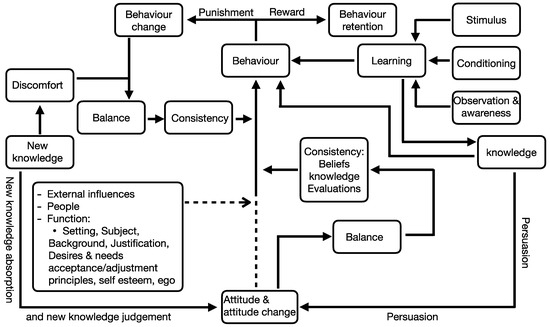
Figure 1
Highly Accessed Articles
Latest Books
E-Mail Alert
News
Topics

Conferences
Special Issues
Special Issue in
Challenges
Nurturing Connected Consciousness in the Anthropocene: Addressing Calls for Cultural and Spiritual Transformation as a Path to Personal, Collective, and Planetary Health
Guest Editors: Heidi Honegger Rogers, Mona S. El-Sherbini, Sara L. Warber, Knellee Bisram, Cindy XieDeadline: 31 October 2024
Special Issue in
Challenges
Planetary Health: From Evidence to Action–Confronting Reality (Including Submissions Associated with the 2024 Planetary Health Summit (PHAM2024)
Guest Editors: Jemilah Mahmood, Marie Studer, Elil Renganathan, Fatimah Ahamad, Menaka Ganeson, Susan PrescottDeadline: 30 November 2024
Special Issue in
Challenges
The Relationship between Sustainability and Inner Development: Towards More Integrative Worldviews, Paradigms, and Actions
Guest Editors: Kristian Stålne, Christine Wamsler, Susan Prescott, Kristofer Vernmark, Jonathan Reams, Vivianna Rodriguez Carreon, Kira Cooper, Stefani Greca, Lene SøvoldDeadline: 14 December 2024



